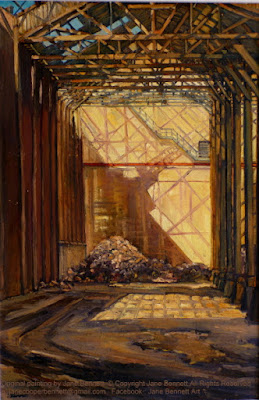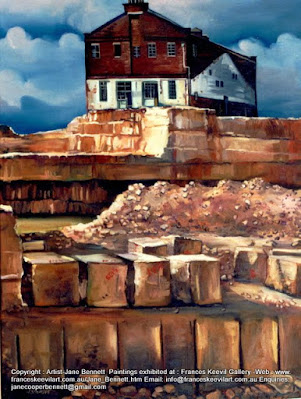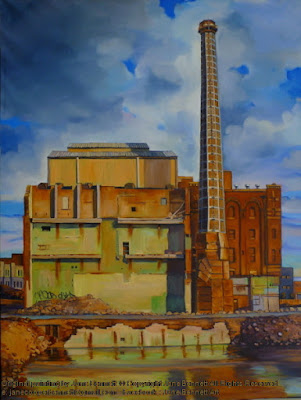I jumped the fence and painted some small plein air canvases while it was being demolished.
 |
| "Half demolished apartment block in Cowper Street Glebe/Ultimo" 2011 oil on canvas 15 x 15cm Enquiries |
The 'Mirragang' at first sight looks quite presentable, until the lack of glass in the windows hints at something not quite right....
 |
'Open Plan' -half demolished apartment block
in Cowper Street Glebe/Ultimo" 2011 oil on canvas 13 x 18cm Enquiries
The shell of the 'Mirragang' apartments on the left, and the 'Mirrabooka' on the right, frame the handsome dark brick building in the centre.
This former wool bond store, the Farmers and Graziers No 2 Store, was the last of the great bond stores, and replaced a swath of houses in 1936.
The low-lying swampy area of Glebe and Ultimo has always been known for cheap and often nasty housing.
From the 1850s onwards, a jumble of workshops, slaughter yards, boiling-down works and other scrappy industries sprang up around the noxious waters of Blackwattle Creek. Cramped cottages without water or sewerage, were erected by landlords for the working poor. People lived cheek by jowl with domestic animals. Refuse and offal from the slaughter yards often remained to rot on the mudflats. The abattoirs provided the bones to be burnt in the Char Tower of the CSR Distillery, which were used to filter sugar. And all of the residue was pumped right back into the Blackwattle Creek.
However uninspired these redbrick tower blocks looked, they were a vast improvement on their predecessors. Mind you, that wouldn't have been hard. Almost anything would have been.
|
 |
| 'Open House' - 2011 oil on canvas 25 x 20cm Available Enquiries |
These 15 public housing apartment blocks in Cowper Street, Glebe, were demolished by the state Labor government in 2011, resulting in the eviction of 130 tenants. Although new housing on the site was promised, to be funded by the proceeds of money raised by the sale of 99-year leases to Millers Point terraces, the land was left vacant for years as a development application was lodged and contested in court.
The O'Farrell cabinet approved construction plans for 153 public housing units, 95 affordable housing units and 247 private apartments on the site in 2013.
Now the Baird government has finally announced plans to rebuild this demolished public housing estate on Cowper Street as a mixed
private, public and affordable housing community.
Related Posts
















